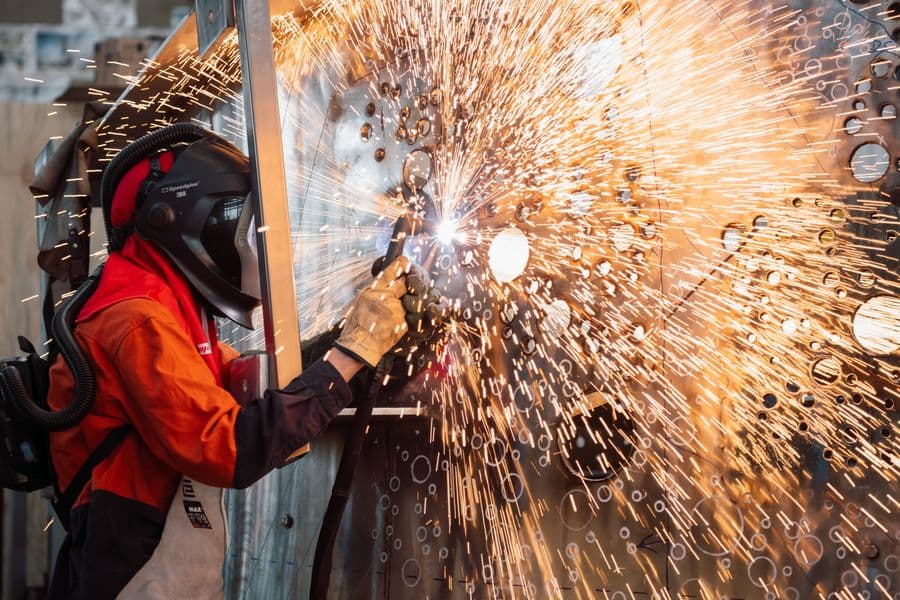Lindy Lee
Broadsheet Studio Visit

Lindy Lee, Studio Visit 2023, image credit: Nelly le Comte Broadsheet
'This area is the most beautiful country I’ve ever been in,' LINDY LEE says. 'It’s where heaven meets earth. Every morning I wake up and look across the valley, with lush green hills dappled with sunlight, and it’s just so peaceful.'
A strong burning smell wafts through the large corrugated-iron shed where Lindy Lee stands pointing out her 'works in progress'. On the adjoining deck, one of her four studio assistants is hard at work – earphones firmly in place – helping create a 'charred forest' that will be part of an upcoming exhibition at the National Gallery of Australia.
Thick five-metre-long paper scrolls dotted with seared holes line the walls of the studio. Inside Lee, one of Australia’s foremost contemporary artists, is explaining her passion for experimenting with nature.
'These are like barnacles,' she says as she holds the paper out towards me. 'These patterns exist already in the natural world.'

Lindy Lee, Studio Visit 2023, image: Nelly le Comte Broadsheet
Lee’s work explores her Chinese ancestry through the lens of Taoism and Ch’an (Zen) Buddhism, philosophies that see humanity and nature as inextricably linked. So it’s not hard to see how the Brisbane-born artist has ended up here, in the middle of a rainforest in the in the Byron Bay hinterland hamlet of Coorabell.
She and her husband Rob Scott-Mitchell, who passed away two years ago, used to holiday each summer in a house just down the hill. Knowing Lee was an artist, the owner invited them to buy a different cottage on the property, which included a small studio. 'Rob and I didn’t know how we could afford it because we were both artists and I wasn’t earning any money as an artist at that point,' Lee says.
But when she was offered a redundancy from her role as a lecturer at the Sydney College of the Arts eight years ago, they had enough for a deposit.
'Art allowed me to ask questions about who and what I am.'
'This area is the most beautiful country I’ve ever been in,' Lee says. 'There are incredible vistas … and the horizon line is a daily inspiration. It’s where heaven meets earth. Every morning I wake up and look across the valley, with lush green hills dappled with sunlight, and it’s just so peaceful.'
The studio was never going to be big enough for Lee’s work, so she added an extension immediately. But it still wasn’t enough. One of her works, Moonlight Deities, is four metres tall. When it was complete she realised she couldn’t get it out. A year ago she finally had enough money to extend the studio, creating a large shed with a high tilted roof, downlights, plenty of storage space, a kitchenette and roller doors at both ends.

Lindy Lee, The long road of the river of stars, 2015, National Gallery of Australia, Kamberri/Canberra, purchased 2018
The original studio beside her workspace now houses two Ukrainian refugees. One of Lee’s studio assistants helped bring her friend and her friend’s three-year-old son to Australia after their country was invaded. As the daughter of Chinese immigrants who fled the country after the rise of communism, Lee is empathetic to their plight.
One of her best-known works, The Seamless Tomb, revolves around an old black-and-white photo of her family, with her dad in a suit before he boarded a ship to Australia. It was eight long years before her mother and two older brothers were able to join him. Growing up in Queensland when Joh Bjelke-Petersen was premier has had a major influence on the 69-year-old’s life. 'There was a lot of racism, and a sense of not belonging,' she says. 'Art allowed me to ask questions about who and what I am.'
One of her current projects, Ouroboros, is based on the ancient image of a snake eating its own tail. The work was partly inspired by the mythological Chinese dragon, and partly by the rainbow serpent from Indigenous culture. 'I feel there’s a very strong connection between Aboriginal spirituality and ancient Chinese spirituality and I wanted to build some connection to Country – in the First Nations sense – into Ouroboros,' Lee says of the work, which is currently being fabricated at Urban Art Projects foundry in Brisbane.
Measuring around four metres high, Ouroboros will be the first artwork Lee has produced that people will be able to walk through. 'There will be shafts of light coming in through the perforations,' she says. 'I’m hoping it will be this magical, wondrous place.'
Ouroboros was commissioned to celebrate the National Gallery's 40th anniversary in 2022 and is due to be completed in 2024.
Broadsheet’s Studio Visit series takes a peek inside the creative spaces of Australia’s best artists, designers and makers. This article was first published on Broadsheet in August 2023.




